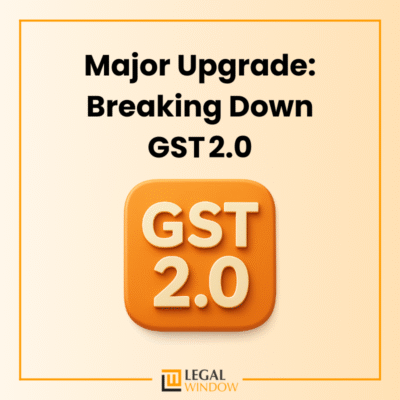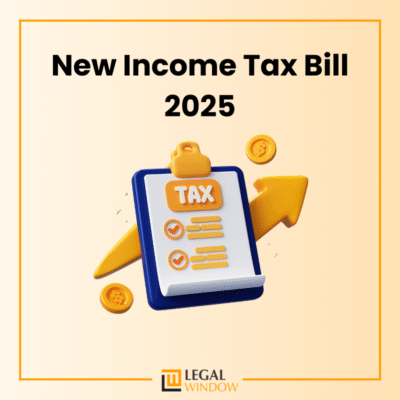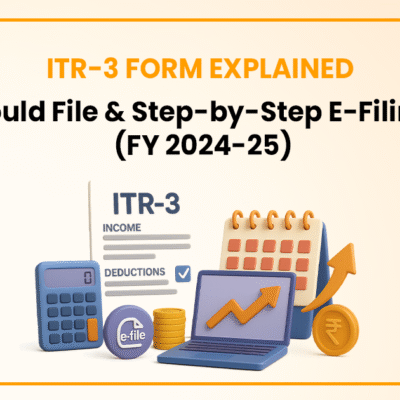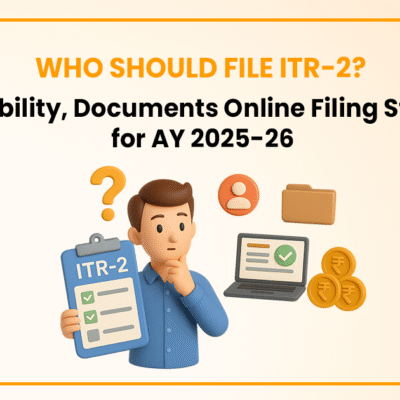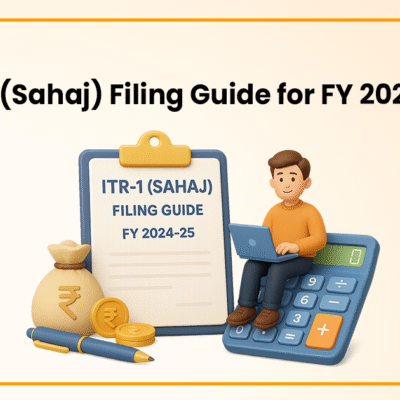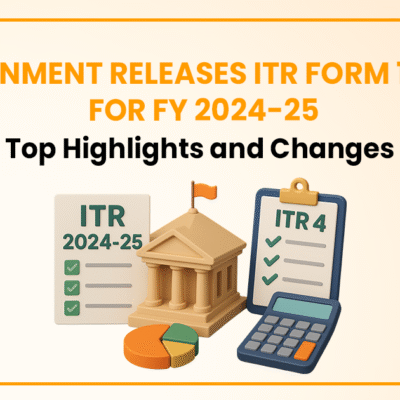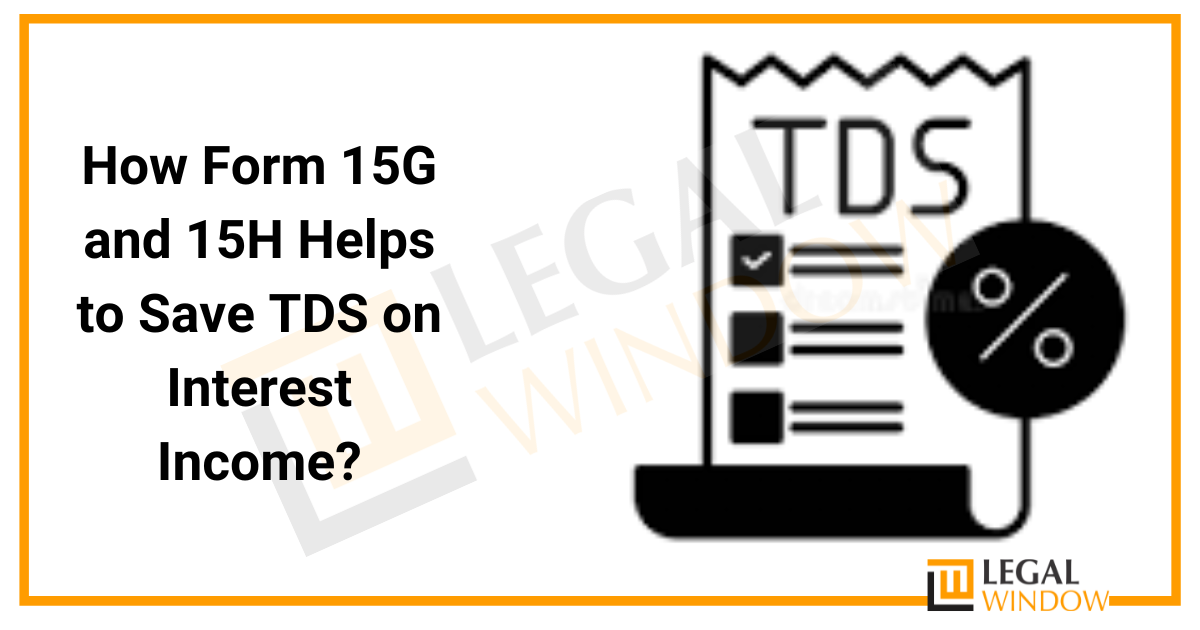
Form 15G and Form 15H are used to save TDS (Tax Deducted at Source) on interest income earned by individuals. TDS is a tax deducted by the payer (bank or financial institution) on the interest paid to the individual. Form 15G is used by individuals below 60 years of age, while Form 15H is used by senior citizens (60 years or above). These forms are used to declare that the individual's total income for the financial year is below the taxable limit and hence, no TDS should be deducted on the interest income earned. This article will contain the information related to Form 15G and 15H helps to save TDS on Interest income.
Brief about Form 15G and 15H
Form 15G and Form 15H are forms that can be submitted to the income tax department by individuals to request exemption from the TDS on their income, specifically on interest income earned on fixed deposits, recurring deposits, or any other kind of deposit with a bank or financial institution. Form 15G can be filled by individuals who are below 60 years of age, while Form 15H can be filled by senior citizens who are 60 years or above. The forms can be submitted at the beginning of the financial year or when the interest income is earned, whichever is earlier.
By submitting Form 15G or Form 15H, the individual is declaring that their total income for the financial year is below the taxable limit, therefore, no TDS should be deducted on the interest income earned. This saves the individual from having to pay tax on their interest income.
Importance of form 15G and 15H?
Form 15G and Form 15H are important declaration forms that can help individuals avoid TDS on their interest income. The importance of Form 15G and Form 15H are as follows:
- Avoid TDS: The primary importance of Form 15G and Form 15H is that they help individuals avoid TDS on their interest income. If an individual's total income for the financial year is below the taxable limit, they can declare the same in Form 15G or Form 15H and avoid TDS on the interest income earned.
- Cash Flow Management: By avoiding TDS on interest income, individuals can improve their cash flow as they will not have to wait for the TDS refund.
- Reducing the Burden of Filing Tax Return: If an individual's total income for the financial year is below the taxable limit, they are not required to file an income tax return. By submitting Form 15G or Form 15H and avoiding TDS, individuals can save themselves from the burden of filing an income tax return.
- Time-saving: By submitting Form 15G or Form 15H, individuals can save time and effort required for filing TDS refund claims and follow-ups with the income tax department.
- Simplified process: Form 15G and Form 15H are simple declaration forms that can be filled easily by individuals. These forms do not require any supporting documents, making the process simpler and more accessible for taxpayers.
Documents required to fill the form 15G and 15H
There are no specific documents required to fill Form 15G and Form 15H. These forms are simple self-declaration forms that can be filled and submitted by individuals without any supporting documents.
However, individuals must ensure that they provide accurate and truthful information while filling the forms. The following details must be provided while filling Form 15G and Form 15H:
- Personal Details: Name, address, PAN, and age of the individual.
- Bank or Institution Details: Name of the bank or financial institution, branch details, and the type of deposit scheme.
- Estimated Income for the Financial Year: Details of estimated income from all sources for the financial year for which the form is being submitted.
- Eligibility Criteria: Declaration of eligibility under the relevant sections of the Income Tax Act, 1961.
- Signature: Signature of the individual submitting the form.
- If you are providing false information can lead to legal action and penalties. Therefore, individuals must ensure that they provide accurate information while filling the forms.
Eligibility Criteria to fill the form 15G and 15H
The eligibility criteria for submitting Form 15G and Form 15H are based on the following sections of the Income Tax Act, 1961:
- Section 197A(1): This section allows individuals to submit Form 15G if they are residents of India and their estimated total income, including interest income, is below the taxable limit. Individuals can submit this form to request the payer not to deduct TDS on their interest income.
- Section 197A(1C): This section allows individuals who are 60 years of age or above to submit Form 15H if their estimated total income, including interest income, is below the taxable limit. Individuals can submit this form to request the payer not to deduct TDS on their interest income.
- Rule 29C: This rule applies to individuals who are claiming exemption from TDS on interest income earned on securities. Individuals can submit Form 15G to the payer if their estimated total income, including interest income, is below the taxable limit, and they satisfy the conditions specified under this rule.
When should you submit Form 15G and Form 15H?
Form 15G and Form 15H should be submitted at the beginning of each financial year or when the interest income is earned, whichever is earlier. The forms should be submitted by individuals who are eligible to declare that their total income for the financial year is below the taxable limit. Form 15G can be submitted by individuals who are below 60 years of age and their taxable income for the financial year should not exceed the basic exemption limit. As per the current tax laws, the basic exemption limit for the financial year 2022-23 is Rs. 2.5 lakh.
Form 15H can be submitted by senior citizens who are 60 years or above and their taxable income for the financial year should not exceed the basic exemption limit. For senior citizens, the basic exemption limit for the financial year 2022-23 is Rs. 3 lakh.
If an individual's total income for the financial year exceeds the taxable limit, they should not submit Form 15G or Form 15H. If an individual submits a false declaration, they may be liable for penalties and legal action.
Forgot to submit Form 15G or Form 15H?
If an individual forgot to submit Form 15G/Form 15H and TDS has already been deducted on the interest income earned. They can still claim a refund for the TDS deducted by filing their income tax return.
While filing the income tax return, the individual can claim a refund for the excess TDS deducted. The refund will be processed by the income tax department after verifying the income details of the individual.
However, the individual should only file the ITR, if their total income for the financial year exceeds the taxable limit. If the individual's total income for the financial year is below the taxable limit, they are not required to file an income tax return.
To avoid such situations in the future, it is advisable to submit Form 15G/ Form 15H at the beginning of the financial year or when the interest income is earned, whichever is earlier. If the individual is eligible to declare that their total income for the financial year is below the taxable limit.
Where can you submit Form 15G or Form 15H apart from banks?
Form 15G and Form 15H can be submitted to the income tax department or the bank or financial institution where the deposit is held. Apart from banks, some other institutions may also accept these forms. Such as post offices, co-operative societies, and other financial institutions that offer deposit schemes.
In addition, some institutions may have their own format for declaration forms similar to Form 15G and Form 15H. For example, some mutual fund companies may have their own form for submission by investors to avoid TDS on dividends. It is important to verify with the institution whether they accept Form 15G/Form 15H or any other declaration form. The institution to which the form submits should be the one that will pay the interest income on the deposit. If the deposit is held with multiple institutions, the forms should be submitted to each of those institutions separately.
How to fill Form 15G and 15H?
To fill Form 15G and 15H, you will need to follow the steps mentioned below:
- Step 1: Download the Form 15G and 15H from the official website of the Income Tax Department or obtain a physical copy from the bank or financial institution.
- Step 2: Fill in your personal details such as your name, address, PAN, and other relevant details.
- Step 3: Fill in your financial details such as the name of the bank or financial institution, branch details, and the type of deposit scheme.
- Step 4: Declare your eligibility by filling in the details of the estimated total income for the financial year and the tax calculated on it. Also, declare that the tax on the estimated total income for the financial year has already been paid.
- Step 5: Sign and date the form at the bottom.
- Step 6: Submit the completed Form 15G and 15H to the bank or financial institution where the deposit is held or to the income tax department, as applicable.
- it is important to note that while filling Form 15G and 15H, the details provided should be accurate and truthful. Providing false information can lead to legal action and penalties.
How Form 15G and 15H Helps to Save TDS on Interest Income?
One of the most common sources of income for individuals is interest earned on fixed deposits, savings accounts, and other similar financial instruments. However, the interest earned on such investments is subject to Tax Deduction at Source (TDS) by banks and other financial institutions. TDS is deducted at a rate of 10% if the interest income exceeds Rs. 40,000 per year. However, if you are eligible, you can submit Form 15G or 15H to the bank to avoid TDS on interest income.
When an individual submits Form 15G or 15H to the bank or financial institution, they declare that their income is below the taxable limit, and hence, no TDS needs to be deducted from their interest income. If the bank or financial institution finds that the individual is eligible, they will not deduct any TDS from their interest income.
Takeaway
Form 15G and 15H are self-declaration forms that individuals can submit to banks and other financial institutions to avoid TDS on their interest income. These forms are applicable to individuals who meet the eligibility criteria, and their income is below the taxable limit. By submitting these forms, individuals can save TDS on their interest income and increase their savings. However, it is essential to ensure that the eligibility criteria are met before submitting these forms to avoid any legal consequences. Connect with our experts at Legal Window in case you need assistance in Filing of Form 15G and 15H Helps to Save TDS on Interest Income. Our Experts would be Happy to Help. You can also get your TDS Return through us, and be a part of our Happy Customer Family.
Company Secretary and diligent learner deeply immersed in the world of corporate law, compliance, and governance with a focus on developing a robust foundation in legal principles and corporate practices. Passionate about exploring the intricacies of company law, regulatory compliance, and corporate governance.
Categories
- Agreement Drafting (23)
- Annual Compliance (13)
- Change in Business (37)
- Company Law (150)
- Compliance (90)
- Digital Banking (3)
- Drug License (4)
- FEMA (17)
- Finance Company (42)
- Foreign Taxation (9)
- FSSAI License/Registration (15)
- GST (124)
- Hallmark Registration (1)
- Income Tax (214)
- Latest News (36)
- Miscellaneous (170)
- NBFC Registration (8)
- NGO (18)
- SEBI Registration (6)
- Section 8 Company (10)
- Start and manage a business (27)
- Startup/ Registration (134)
- Trademark Registration/IPR (48)
Recent Posts
- Major Upgrade: Breaking Down GST 2.0 September 15, 2025
- New Income Tax Bill 2025 August 27, 2025
- ITR-3 Form Explained: Who Should File & Step-by-Step E-Filing Guide (FY 2024-25) June 25, 2025
All Website Tags
About us
LegalWindow.in is a professional technology driven platform of multidisciplined experts like CA/CS/Lawyers spanning with an aim to provide concrete solution to individuals, start-ups and other business organisation by maximising their growth at an affordable cost.


